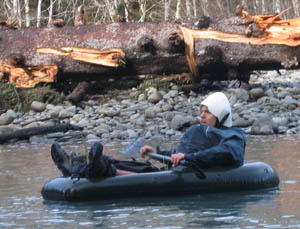Home | Trips | Food | Gear | Packrafts | Pebble Mine | About us | Ground Truth Trekking
Sevylor Trail Boat


Sevylor trail boat on the Queets river, WA
The only Sevylor product I've used is the Trail Boat. We took a pair of these down the AK peninsula in 2001. Their main advantage is that they're really cheap - only $60 for the raft (2007), and the little plastic paddle that comes with it. The secondary advantage is that they're really light - only about 3 pounds, with paddles included. Their main problem is that they're really fragile and have a number of design flaws. There's a reason that the warning in the boat says to "use only in calm water with a lifeguard present"
Raft Durability
There are many things that can go wrong with a Sevylor. Here are some of the major problems we've found.
Fragile fabric - In general, the rafts are quite vulnerable to sharp rocks, sticks, and other obstacles. We had to patch the main tube a lot.
Floor compartment - The floor takes the most abuse of any part of the raft, and it's not any tougher than the rest. We found that the inflatable floor is quickly shredded, and not worth patching. The raft will still float just fine, but you'll be sitting right against the water.
Emergency deflation rings - The trail boat comes with plastic rings that look like you're supposed to tie something to them. Cut these off immediately. Even a gentle tug (pulling an empty raft), can cause them to pull off, deflating the entire boat.
Paddle Durability
The paddles that come with a Sevylor are actually more of a danger than the rafts themselves. It would be possible, but heavier, to carry a Sevylor with a real kayak paddle.
Overtightening - Immediately after we started using them, we discovered the paddles would overtighten and pop loose during paddling. Needless to say, this is a problem when trying to quickly cross a river. Lashing the threads with twine helped somewhat.
Snapping in half - Both Hig and I had the Sevylor paddle snap clean in half while paddling in a calm lake. And this was already our second set of paddles on that 2 month trip. We were able to improvise by lashing the two halves to a stick, but I'm very glad that didn't happen in the middle of a river crossing.
Design and Handling
Sevylors have a pretty low profile above the water, and it doesn't take much of a wave at all to slop over the bow. Also, they don't have a seat, so you'll be sitting right in the puddle of water. Sevylors take less air to inflate than Alpackas, but they don't come with an inflation bag. It takes probably 20 minutes to blow one up by mouth. Alternately, you could bring a pump and increase the weight.
As with all packrafts, the act of paddling slops some water into the boat, and they don't track at all.
Conclusion
This review is basically a warning about the faults of the Sevylor, which are many. However, Sevylor trail boats are a viable option for some kinds of trips, if you're willing to keep patching them. They will work for crossing rivers that are deep but relatively calm, floating down very calm rivers, and paddling in lakes (if you stick to the shore so you can reinflate the boat when necessary).
Home | Trips | Food | Gear | Packrafts | Pebble Mine | About us | Ground Truth Trekking
All content copyright Erin McKittrick
contact me at mckittre at gmail dot com
Last modified 4/17/07